England’s coronavirus outbreak has shrunk to levels not seen since mid-September, according to two separate reports by Public Health England and NHS Test and Trace.
The number of positive tests recorded last week was lower than at any point since the start of the second wave and cases came down in all age groups and regions over recent weeks.
And the picture is positive over almost the entire country, with case counts coming down in 134 out of 149 local authorities – although there were 15 areas that recorded growing outbreaks in the week up to February 21.
Chief medical officers in all four nations of the UK today agreed to downgrade the Covid threat level from Level 5 – ‘a material risk of healthcare services being overwhelmed’ – to Level 4, which says a ‘Covid epidemic is in general circulation; transmission is high or rising exponentially’.
NHS Test and Trace’s data showed just 84,310 people tested positive nationwide in the week to last Wednesday, a drop of almost half from 149,000 two weeks earlier.
More recent Public Health England figures showed a similar decline and also revealed that nine out of 10 areas had shrinking outbreaks up to Sunday, February 21. However, some saw significant growth, with cases almost doubling in Rutland.
September 20 was the last time that cases were lower in every region and every age group than they are now.
However, the total number of people carrying the virus is thought to be considerably higher now than it was then – 481,000 at the last estimate, compared to 104,000 in mid-September – and there are far more people currently in hospital with Covid, at 14,100 on February 22 compared to 1,174 on September 20.
Anti-lockdown Tory MPs, spurred on by reams of positive data in recent days and weeks, are keen to press Boris Johnson to move faster with his plans to remove social distancing rules, but the Prime Minister today said there was ‘no wiggle room’. Mr Johnson said: ‘We’re sticking to our plan.’
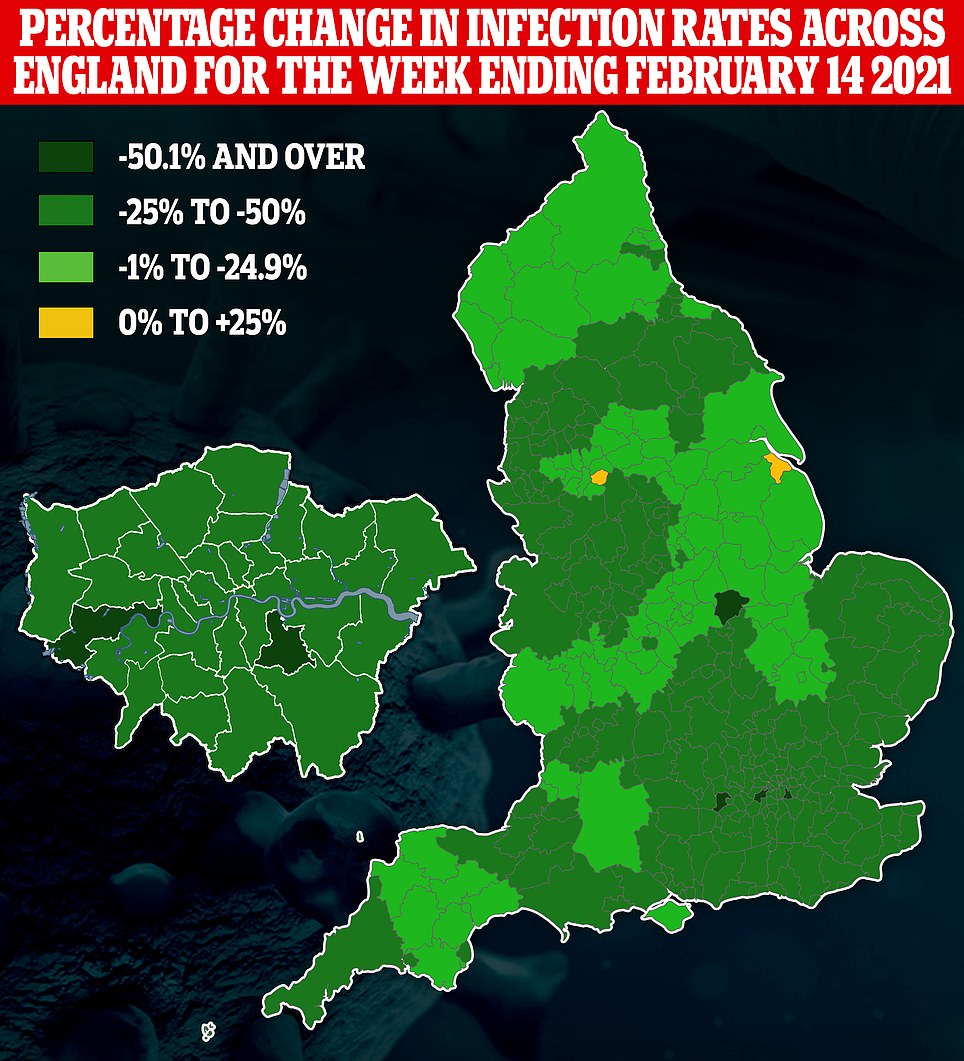
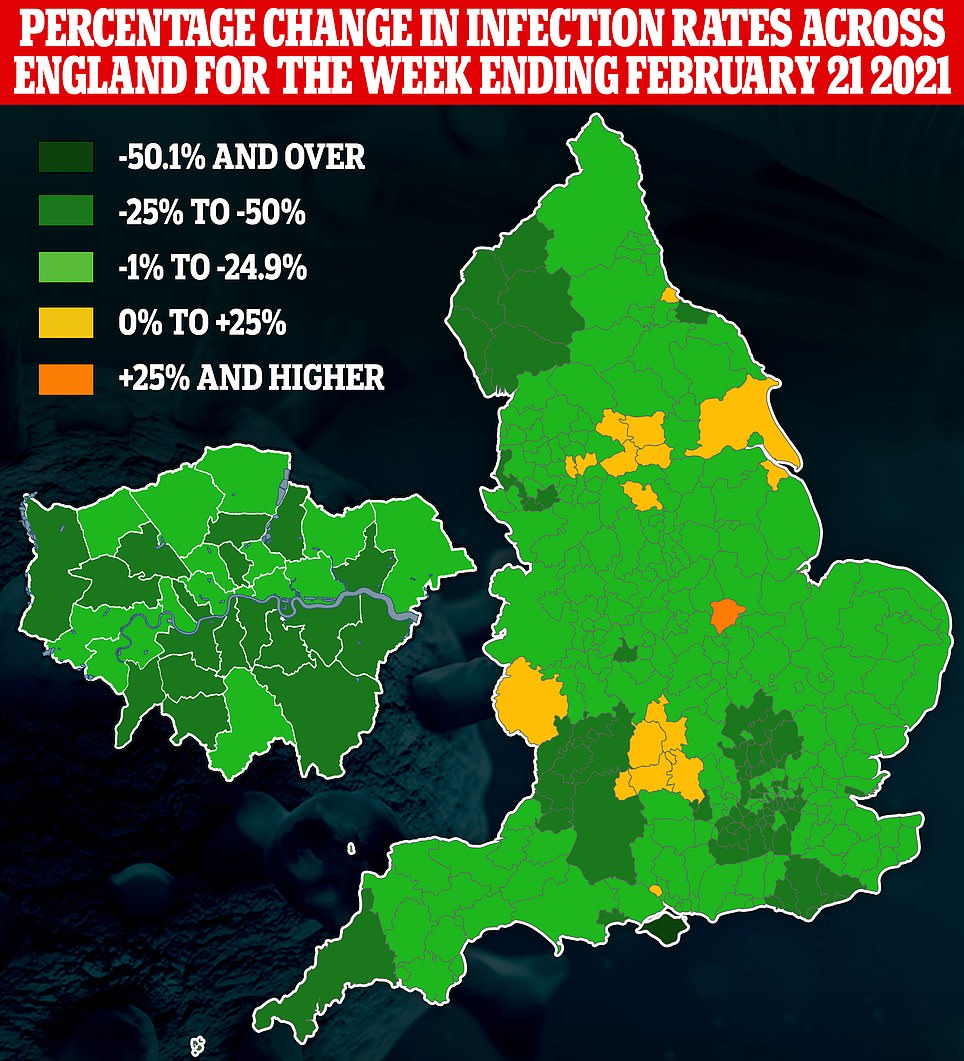 ‹ Slide me ›
‹ Slide me ›
Public Health England data show that nine out of 10 areas had shrinking outbreaks up to Sunday, February 21, but some saw significant growth, with cases almost doubling in Rutland from the previous week (ending February 14)
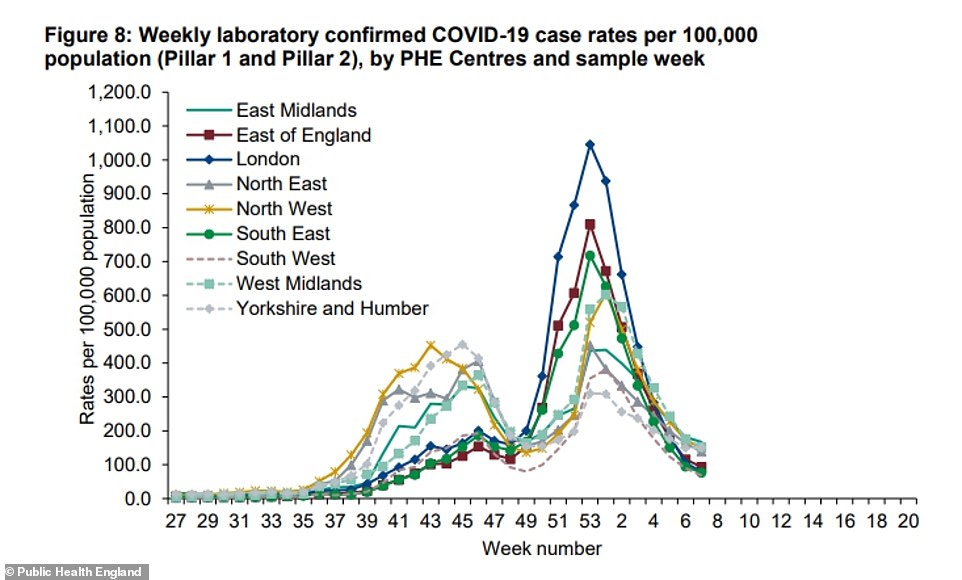
Public Health England data show that September 20 (week 38) was the last time that cases were lower in every region and every age group than they are now
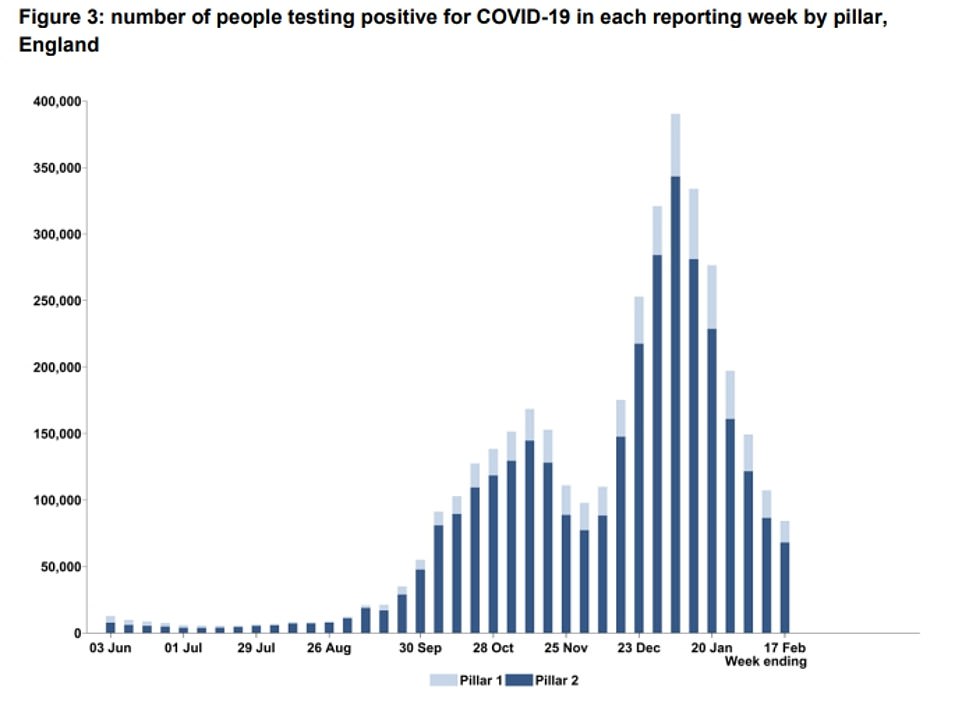
Just 84,310 people tested positive for the coronavirus across the country during the week ending February 17, NHS Test and Trace data revealed today. This is down 44 per cent in a fortnight and is the lowest number since the week to September 30
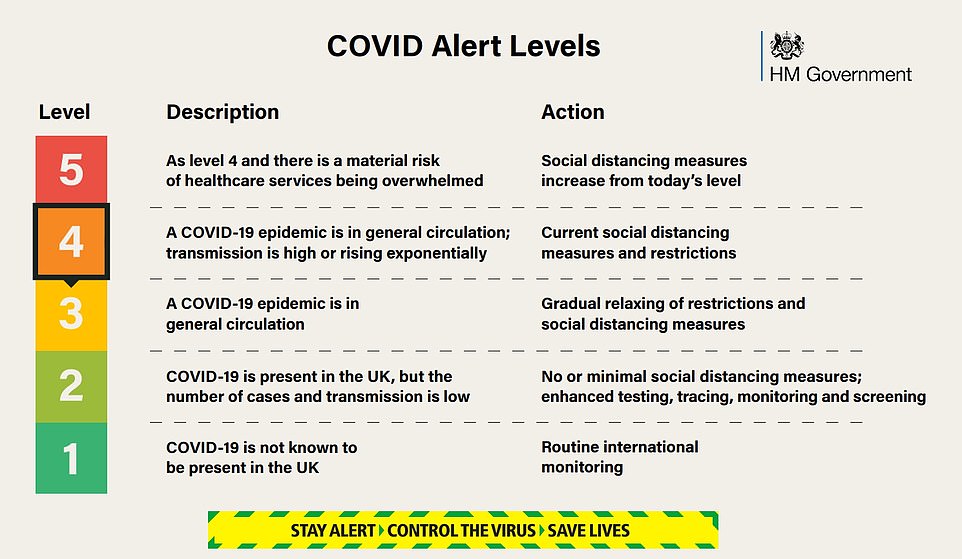
The UK’s chief medical officers today downgraded the Covid alert level from 5 to 4 as data continue to show the epidemic is shrinking
BRITAIN’S COVID ALERT LEVEL IS DOWNGRADED TO FOUR
Britain’s coronavirus alert level was downgraded to level four today as the UK’s chief medical officers said the immediate threat to the NHS had ‘receded’, but they warned the nation wasn’t out of the woods yet.
Despite more good news the Prime Minister again rejected calls to bring forward lockdown easing, saying there was no wiggle room from the dates he laid out in his roadmap on Monday, which will see social distancing rules relaxed no sooner than March 29.
In a statement this afternoon, the UK chief medical officers said that the alert can come down from the top grade – signalling that there is no longer a ‘material risk’ of the NHS being ‘overwhelmed’ within three weeks. But they insisted the public should be under ‘no illusions’ that the threat had gone away entirely.
‘Following advice from the Joint Biosecurity Centre and in the light of the most recent data, the four UK Chief Medical Officers and NHS England National Medical Director agree that the UK alert level should move from level 5 to level 4 in all four nations,’ a statement said.
‘The health services across the four nations remain under significant pressure with a high number of patients in hospital, however thanks to the efforts of public we are now seeing numbers consistently declining, and the threat of the NHS and other health services being overwhelmed within 21 days has receded.’
Advertisement
The chief medical officers – Chris Whitty, Frank Atherton (Wales), Gregor Smith (Scotland) and Michael McBride (Northern Ireland) – said today: ‘ Thanks to the efforts of public we are now seeing numbers consistently declining, and the threat of the NHS and other health services being overwhelmed within 21 days has receded.
‘We should be under no illusions – transmission rates, hospital pressures and deaths are still very high.
‘In time, the vaccines will have a major impact and we encourage everyone to get vaccinated when they receive the offer. However for the time being it is really important that we all – vaccinated or not – remain vigilant and continue to follow the guidelines.’
Test and Trace data show today that 2.6million people got tested for coronavirus in the most recent week, down from 3million the week before and 3.1million in the first week of February.
The number of positive results has plummeted during the lockdown from a peak of 390,366 coronavirus cases recorded in the first week of January, before the national rules came into force.
A total 84,310 last week marks a 78 per cent drop from that peak, with case numbers coming down both in the community and in hospitals.
Virus cases in hospital peaked a week later than in the general population, with a high of 52,911 in the week ending January 13, after Pillar 2 cases – those detected at public testing sites – were highest a week earlier at 343,322.
A PHE report today showed that cases have dropped in all but 15 local authorities in England in the most recent week.
The biggest declines in positive tests per 100,000 people were seen in the Isle of Wight, Bath, Gloucestershire and the London boroughs of Lewisham and Bromley, which all saw their infection numbers fall by between 37 and 57 per cent.
But the 15 places where infection rates increased on the previous week were Rutland, Swindon, Herefordshire, Hartlepool, Bradford, Bury, Sheffield, North East Lincolnshire, Oxfordshire, Kirklees, Leeds, Rochdale, Southampton, East Riding of Yorkshire and Wakefield.
COVID PATIENT NUMBERS FALL IN 98% OF NHS HOSPITALS
Covid inpatient numbers have fallen in all but a handful of England’s hospitals in the past two weeks, official figures revealed.
NHS data showed 135 out of 137 major trusts — 98 per cent — saw a drop in the numbers over the two weeks to February 16.
The Christie in London recorded the biggest rise, after the number of Covid patients it treated went up from 10 to 15, on average.
The second-biggest jump was at the Harrogate and District NHS Trust, Yorkshire, where they increased from 53 to 56 a week.
But they went down in all other trusts, official figures revealed.
The sharpest fall was recorded at the Robert Jones and Agnes Hunt Orthopaedic hospital, in Shropshire, where they dropped by 97 per cent.
However, in terms of crude numbers, the specialist trust went from six to less than one. The figure is the daily average over the week ending February 16.
It was followed by Northern Devon Healthcare NHS Trust, where they dropped 85 per cent from five to less than one on average.
And Yeovil District Hospital NHS Trust, where they fell by 70 per cent from 41 to 11 on average.
Separate data from the Department of Health showed hospitalisations with the disease have been plummeting since January 10 after the third national lockdown was declared.
It takes roughly two weeks for someone infected with the virus to develop symptoms serious enough to be rushed to hospital, meaning there is a lag between the fall in infections and the fall in hospitalisations.
During the darkest days of January hospitals warned they could be overwhelmed by an influx of patients and thousands of routine procedures for other conditions – including cancer and cataract operations – were cancelled or rescheduled.
Advertisement
They saw positive test rates rise by anywhere between 0.3 per cent (Wakefield) and 87 per cent (Rutland).
Rutland, close to Leicestershire in the East Midlands, now has an infection rate of 243 positive tests per 100,000 people.
This makes it the fourth worst affected place in the country, behind Peterborough, Sandwell and Leicester.
As well as its area-by-area breakdown, Public Health England’s numbers also show that positive test numbers are down across most regions and all age groups in the most recent week.
Yorkshire and the Humber was the only region where the infection rate stayed flat.
With this exception and a two-week hiccup in the North West in December, all regions have lower positive test rates than at any time since October or September.
And age group categories all also have significantly lower rates than they did over the winter peak.
Among 20 to 29-year-olds, who had the highest infection rate of all during the second wave – at 939 positives per 100,000, almost one per cent of the population in the first week of January – the number of cases has dropped to just a sixth of its peak, to 157 per 100,000.
Although new infection numbers are tumbling, the ONS estimated last week that the total number of people with the virus at any time is still higher than half a million.
This is a result of the long tail of the huge second wave, with infections still lingering as a result of transmission in late January when there were still over a million people with the virus because of massive spreading before lockdown.
Boris Johnson has said this means the lifting of lockdown rules cannot be sped up, even though Britain has been in the green with cases coming down for over a month now.
On a visit to Accrington Academy in Lancashire today, Mr Johnson said the dates he set out will continue to be the target, with the first social distancing rules relaxed on March 29 at the earliest.
He said: ‘I think it’s very important to have a timetable that is sensible, that is cautious, but one that is also irreversible. And that’s the virtue of the timetable we have set out.
‘Everybody knows the dates: March 8, kids back in school; April 12, shops reopen; May 17, hospitality reopens; June 21, we hope, if all things go according to plan, a general reopening…
‘We’re sticking to our plan. Obviously we will continue to look at data but the data currently still shows, as you know, that the incidence of the disease, sadly, remains high.’
He added: ‘I’m afraid the numbers of people in hospital are still not far below the peak that they were in April last year.
‘So we think that the road map that we’ve set out is a good and balanced one for us to get on a journey that is cautious but, as I say, irreversible as well.’
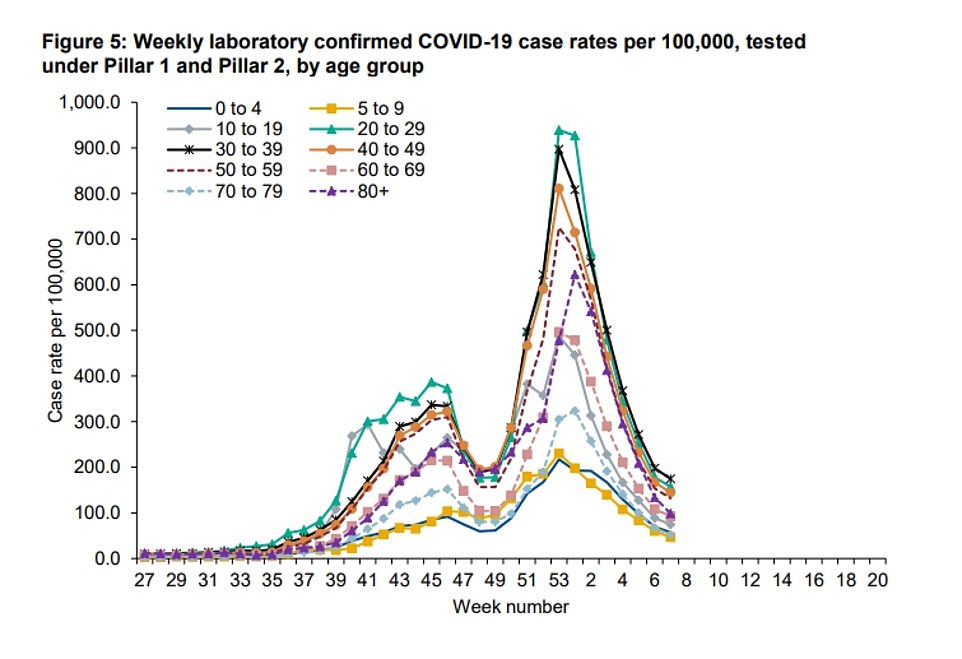
Age group categories all also have significantly lower rates than they did over the winter peak. Among 20 to 29-year-olds, who had the highest infection rate of all during the second wave – at 939 positives per 100,000, almost one per cent of the population in the first week of January – the number of cases has dropped to just a sixth of its peak, to 157 per 100,000

Nearly 4,500 people are being treated in hospital beds every day in England up more than 40 per cent for this time of year amid the Covid pandemic (left). Pressure on hospital intensive care units has fallen nearly 25 per cent in the last month (right), but there are still nearly 1,500 more people in hospital beds than this time last year
INTENSIVE CARE PATIENTS DOWN 25% IN A MONTH
The number of critically-ill patients taking up intensive care beds in NHS hospitals in England has dropped by a quarter over the last month, official figures revealed today.
But there are still nearly 4,500 people being treated in critical care units each day, according to figures that lay bare the huge amount of pressure Covid has thrust onto the stretched health service.
For comparison, around 3,100 ICU beds were occupied during the same week — between February 15 and 21 — over the past four winters.
Coronavirus cases have dropped rapidly since the start of January, at the peak of the second wave. But it takes longer for pressure to ease on the NHS because of the lag between getting ill, developing symptoms and asking for a test and becoming seriously unwell.
Hospital admissions from Covid began to drop in mid-January, while the total number of infected patients taking up beds only began to fall towards the end of last month. Coronavirus pressure on NHS intensive care units only started to ease at the same time.
The number of critically ill people being treated in beds peaked on January 22 at 5,502 but didn’t begin to drop consistently until February 6.
NHS England data show ICU occupancy rates have fallen by 23 per cent in a month, with 4,241 beds taken up on February 21, the most recent day figures are available for.
But last weeks average of 4,440 occupied beds was 43 per cent higher than the four-year-average over the same week, with coronavirus still piling pressure on the health service.
MailOnline’s analysis of annual intensive care unit figures show the average number of beds occupied between February 15 and 21 during 2017 to 2020 was 3,087.
The NHS England figures don’t break down exactly how many of the beds were occupied by Covid patients — but the rise and fall coincides with England’s second wave.
Advertisement
As the number of people infected with the virus comes down, the Test & Trace service appears to be improving, with 96 per cent of people receiving their test results by the end of the next day
The ‘next day’ results are defined as within 48 hours, however, and the service is still unable to meet Boris Johnson’s ambitious target from the summer.
He told the House of Commons on June 3 he would get ‘all tests turned around within 24 hours by the end of June, except for difficulties with postal tests or insuperable problems like that’.
Some 86.8 per cent of people who were tested for Covid-19 in England in the week ending February 17 at a regional site, local site or mobile testing unit – a so-called ‘in-person’ test – received their result within 24 hours.
This is up slightly from 85.4 per cent in the previous week, and is the highest figure since the week to July 8.
The Department of Health now also records data for rapid tests, known as lateral flow devices, and it found a total of 1,756,402 lateral flow tests were conducted in England in the week to February 17, according to the latest Test and Trace figures.
This is down from a record 2,401,651 rapid tests in the previous week, which officials said coincided with school half-term holidays.
The quick swab tests are now widely used in schools across the country, with teachers using them regularly to detect asymptomatic Covid cases, and they are also used for mass community testing in many areas.
Health minister Lord Bethell said: ‘Week after week these results continue to have an enormous impact. Thanks to NHS Test and Trace’s continued outstanding performance, we are helping to halt the spread of the virus.
‘Around one in three people with COVID-19 are asymptomatic which means every positive rapid test helps us break a chain of transmission we wouldn’t have otherwise identified. To identify these hidden cases NHS Test and Trace is conducting over 1.7million rapid tests per week, and, since January, this has included all school staff.’
Test and Trace chief Dido Harding added: ‘This has been another strong reporting week for NHS Test and Trace as the service continues to evolve in order to reach high proportion of cases and contacts quickly and conveniently.
‘Since the service was launched, 70million PCR tests in the UK have been conducted – more than one for every person living in the UK, which just demonstrates the current scale of NHS Test and Trace.
‘More than 95 per cent of in-person tests now return results the next day, compared to less than 50 per cent in the week ending 23 December, ensuring we are contacting as many people as possible, as quickly as possible, with the service continuing to improve.’
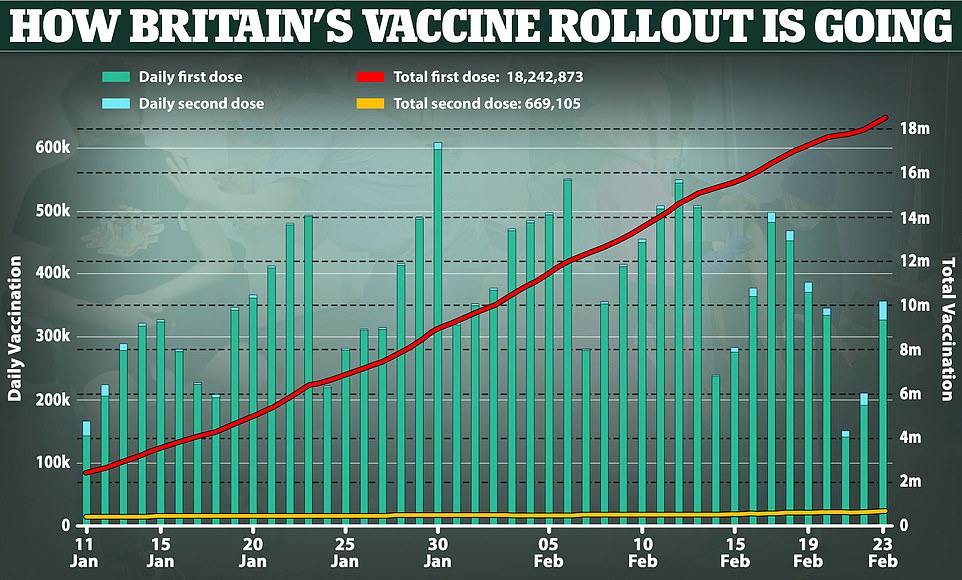
Source link : https://www.dailymail.co.uk/news/article-9299139/Covid-cases-England-hit-lowest-levels-SEPTEMBER.html











